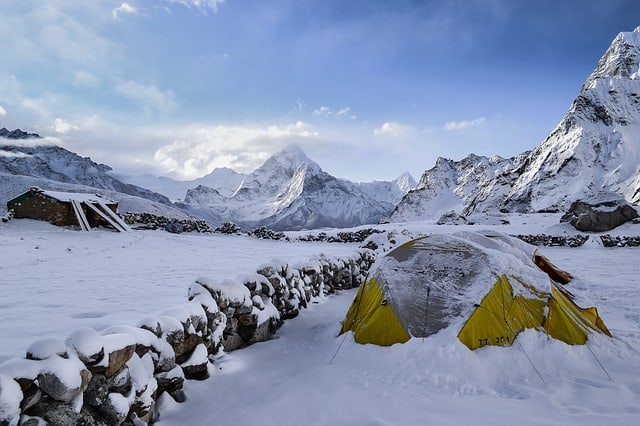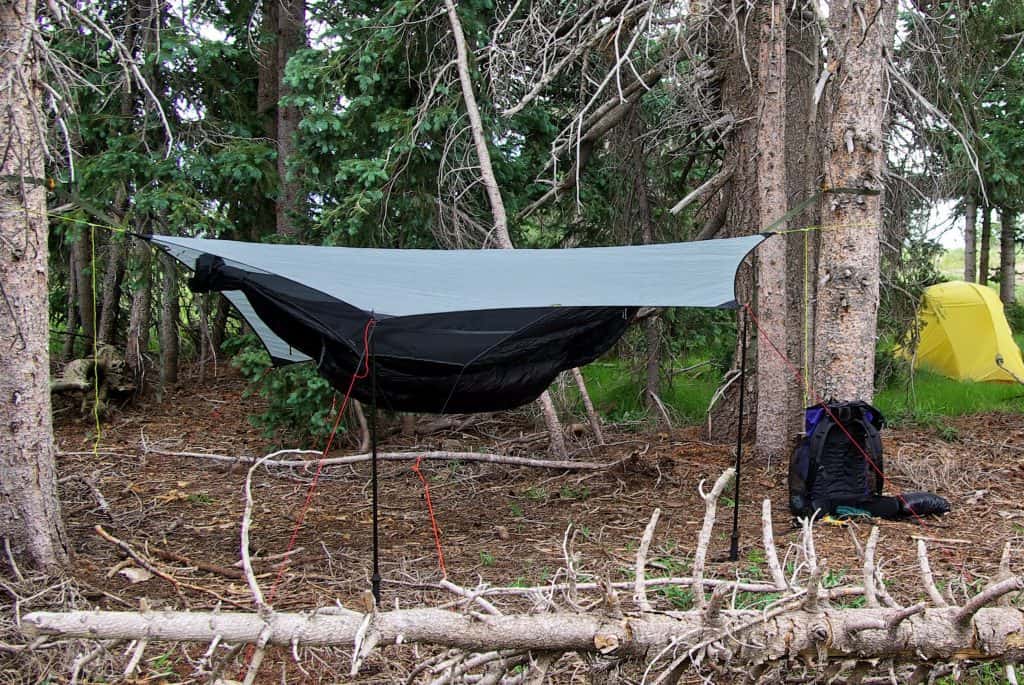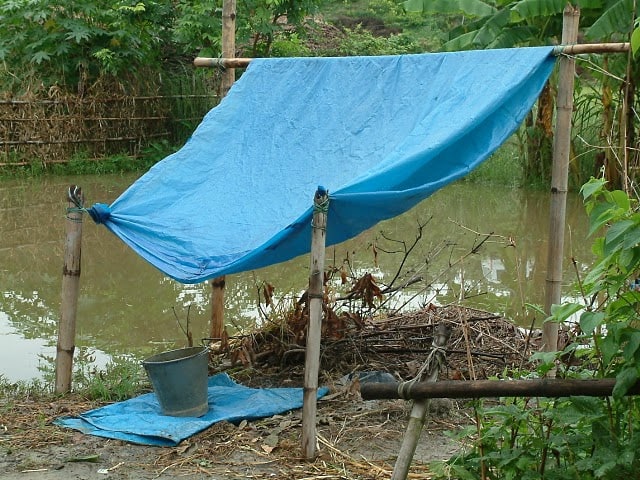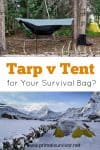If you’ve gotten to the point of asking whether you should pack a tarp or a tent in your survival bag, then you probably already have your Bug Out Bag packed and are familiar with the “survival basics.”
- Shelter
- Water
- Fire
- Food
Some people, like those over at Wilderness College, would also add “attitude” to the list, and some people will put water as the #1 need in certain climates. But it goes without debate that shelter is essential for survival, which is where the tarp or the tent comes in.
I’ve gone camping and done survival simulations (aka drills) using a tent and a tarp. Here are my thoughts on the matter.
*In case you don’t have your bag packed yet, here is a complete bug out essentials list.
Tent Pros and Cons

Pros
- Better Protection: There are many different ways to put up a tarp shelter, but none are as good as the all-around protection that a (quality) tent provides. A good waterproof tent will protect you from all sides. And, if you’ve chosen a tent with a high hydrostatic rating, it will also do an excellent job of trapping your body heat inside.
- Faster to Put Up: Some tarp setups provide just as much protection as a tent, but you’ll have to add some branches, leaves, etc. In other words, it takes a long time to get good protection! By contrast, a tent can be put up in minutes.
- Protection Against Bears and Animals: A thin nylon tent obviously won’t stop a bear. However, the tent does provide a psychological barrier against bears and other animals because they won’t attack what they can’t see. You’ll hear lots of stories from campers who heard bears sniffing around the tents but didn’t go in. An open tarp shelter will not provide this protection.
Cons
- Heavy and Bulky: There are many great lightweight tents out there, but none are as compact as a tarp. Plus, tents don’t serve any other survival purpose, so that’s a lot of space in your Bug Out Bag!
- Expensive: If you are prepping on a budget, buying a quality tent can make a dent in your funds. And there is no point in purchasing a tent if you aren’t going to buy a quality one that can withstand rain, winds, and other severe outdoor conditions.
Recommended Reading – How to Choose the Best Survival Tent
Tarp Pros and Cons

Pros
- Lightweight and Compact: For one person, a tarp for a survival shelter should be at least 7′ x 10′ or 8′ x 10′. You’ll want to go with at least 10′ x 12′ for multiple people. Even a larger tarp than this will still be more compact and lighter than a tent.
- Versatile: There are many survival uses for tarps ranging from collecting rainwater to creating animal traps. When you are limited to how many items you can bring in your survival bag, versatility matters!
- Really Cheap: Tarp materials like Tyvek and Visqueen are ridiculously cheap (probably around $5-$10), and you might even be able to get them free from contractors.
- Get Above Ground: If you know what you are doing, you can string a tarp into a hammock. This will keep you off the cold ground and away from some pesky critters.
- You Can Build a Fire: Tents are enclosed structures, and you can NOT build a fire in one or even near the door. By contrast, (with some tarp shelter designs), you can make a fire in front of or even within the shelter for warmth. When rigged right, the tarp shelter will reflect the heat from the fire to keep you warm.

Cons
- No Insulating Floor: If your tarp is large enough, then you can choose to use a shelter design in which the tarp covers the ground. Even with this setup, you’ll still be on the floor. If it is wet, your body will feel it! There is also a good chance that your sleeping bag will get wet, which could result in hypothermia and death!!!
- Bugs Crawling On You At Night: I don’t mind the bugs so much anymore, but rolling over onto slugs at night is not pleasant! Oh, and there was that time I woke up after a night in a tarp shelter with mosquito bites on my EYELID. I could barely open my eye! Yeah, the bug issue is definitely a downside to choosing a tarp for your survival shelter.
- Higher Learning Curve: Don’t rely on a tarp as your survival shelter unless you’ve tested it out a few times. Looking at survival shelter designs online is one thing, but going out into the wilderness and trying them is entirely different, especially if you need it on a cold, rainy day!
My Stance on the Tent vs. Tarp Debate
For survival needs, tarps are better than tents. However, choosing a tarp for your survival shelter is only wise if you know how to use it! That means knowing how to set up the tarp shelter and being aware of the terrain and ground, so you don’t get wet and hypothermic.
So, tarps are not for newbies! If you are new to survivalism, find an expert or survivalist group to show you how it is done.
Even if you are comfortable using tarps for a survival shelter, it doesn’t mean you have to choose one. I’ve got a family of three. We each – including my 5-year-old daughter – have our own Family Bug Out Bags.
Because we share the load, we have a tarp and a tent between us. One bag has a tarp. The other bag has the tent. If necessary, we could ditch the bag with the tent and still be okay with the tarp.
This is what works for our family. You might take a completely different stance! There is no one right way to prepare for disaster!
Read more about the best survival tarps.
Learn to Make Natural-Material Survival Shelters!
It is great to plan ahead and have a tarp or tent in your survival bag. But what if your survival bag gets lost or stolen?
No gear can compensate for knowledge, so learning how to make survival shelters without any equipment is vital. So start practicing how to make brush shelters, snow shelters, fallen tree shelters, and leaf shelters. You can never be too prepared!
What’s your stance on the tarp vs. tent debate? Which do you prefer and why? Let us know in the comments.
“D’aguilar National Park” (CC BY-NC-ND 2.0) by teejaybeePropagating rain water harvesting in North Bihar (Phase II) by indiawaterportal.org (CC BY-NC-SA 2.0) Found on Flickr.



Tarp. Preferably two or three. A tarp and a wool blanket makes a possible sleeping bag. In a forest, making a lean-to is quite easy. Two tarps can make one pretty snug. One on top of the logs with pine boughs on of it (maybe some sod or mud on top of the boughs) will make an great roof and one over top of pine boughs under the lean-to will make a great bed. Get a fire going and you will beat the cold. (Don’t forget your reflector wall).
It’s terrible. I say tent if at all possible.
What is a billy can?
I would get a really awesome tent AND use a tarp partially over the tent ⛺️ for extra protection. That way, I’d also have something over my head and a place to store firewood when stepping outside my tent. I might even be able to catch rain water.
Laugh if you want, but give me a tent. Watch how bad the people on “Naked and Afraid” get eaten by bugs.
I second the tarp. A tarp made out of gore-tex or similar material is good if you can afford it. A vapor permeable membrane means you can make your tarp into a “burrito” when its cold out and not get too wet from sweat and breath. 2 things I always carry when I’m using just a tarp are a bug headnet, and about of 2′ of light chain with an S hook one one end, and a quick link on the other. The headset is obvious, and it means I don’t have to wrap up to avoid the bugs when it’s warm. The chain, hook, and quick link is for pitching so I can quickly tighten the roof peak line if is starts to rain or blow. If you do it right, your set up will also allow you to hang a billy can over the fire at the end of your tarp. Just don’t get the fire too close to the tarp.
Really good stuff misneac – thanks for your input.
Great advice.